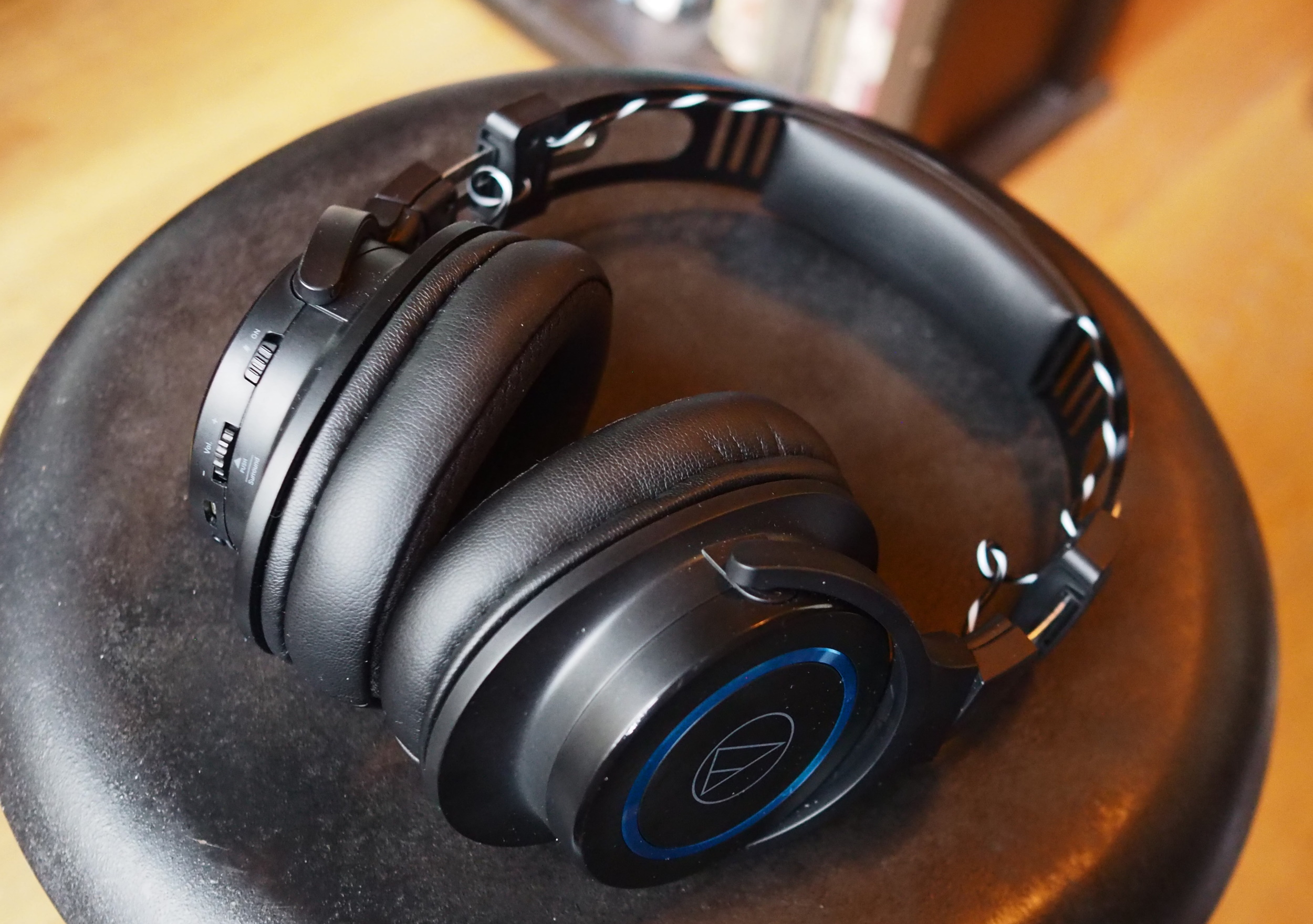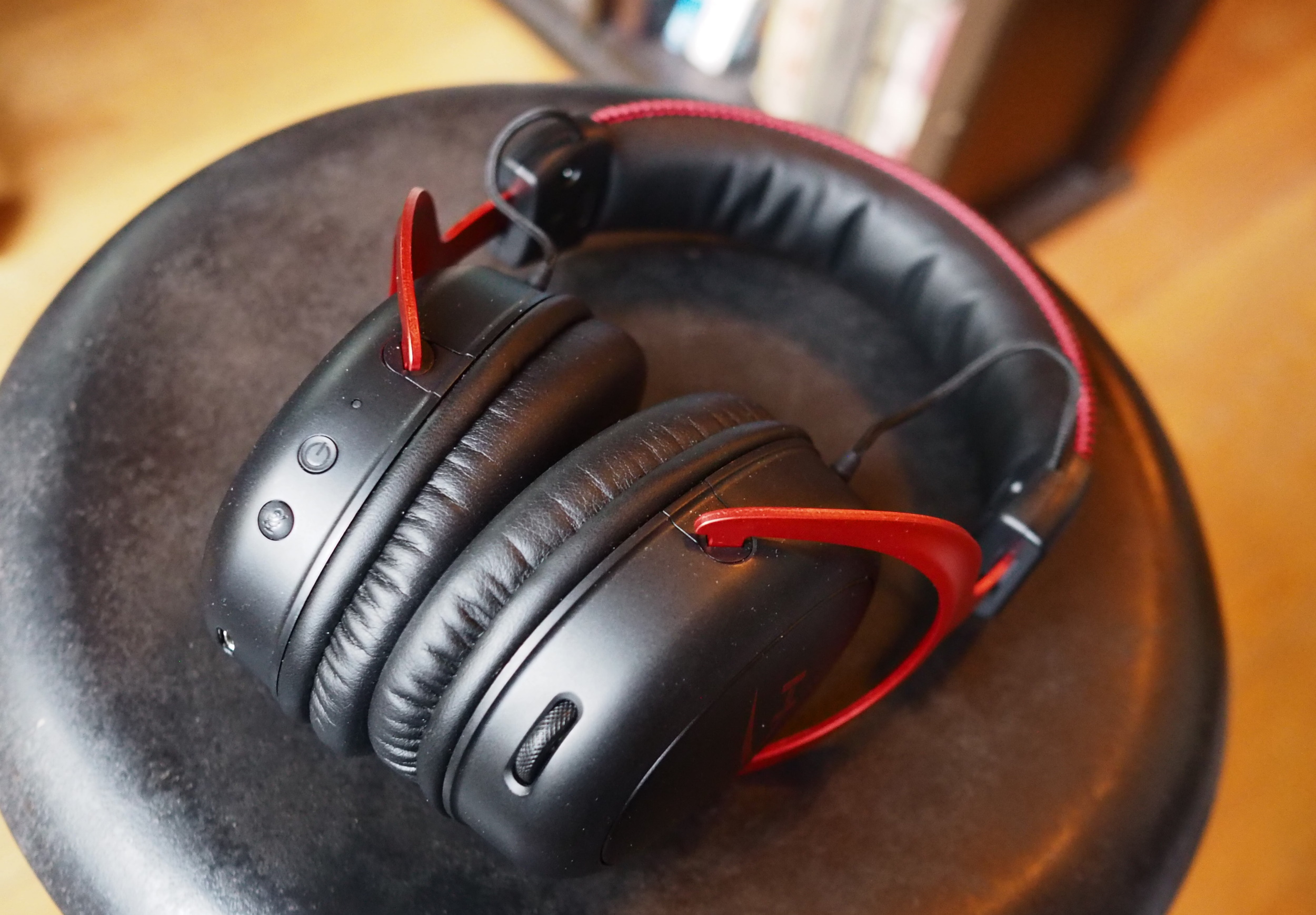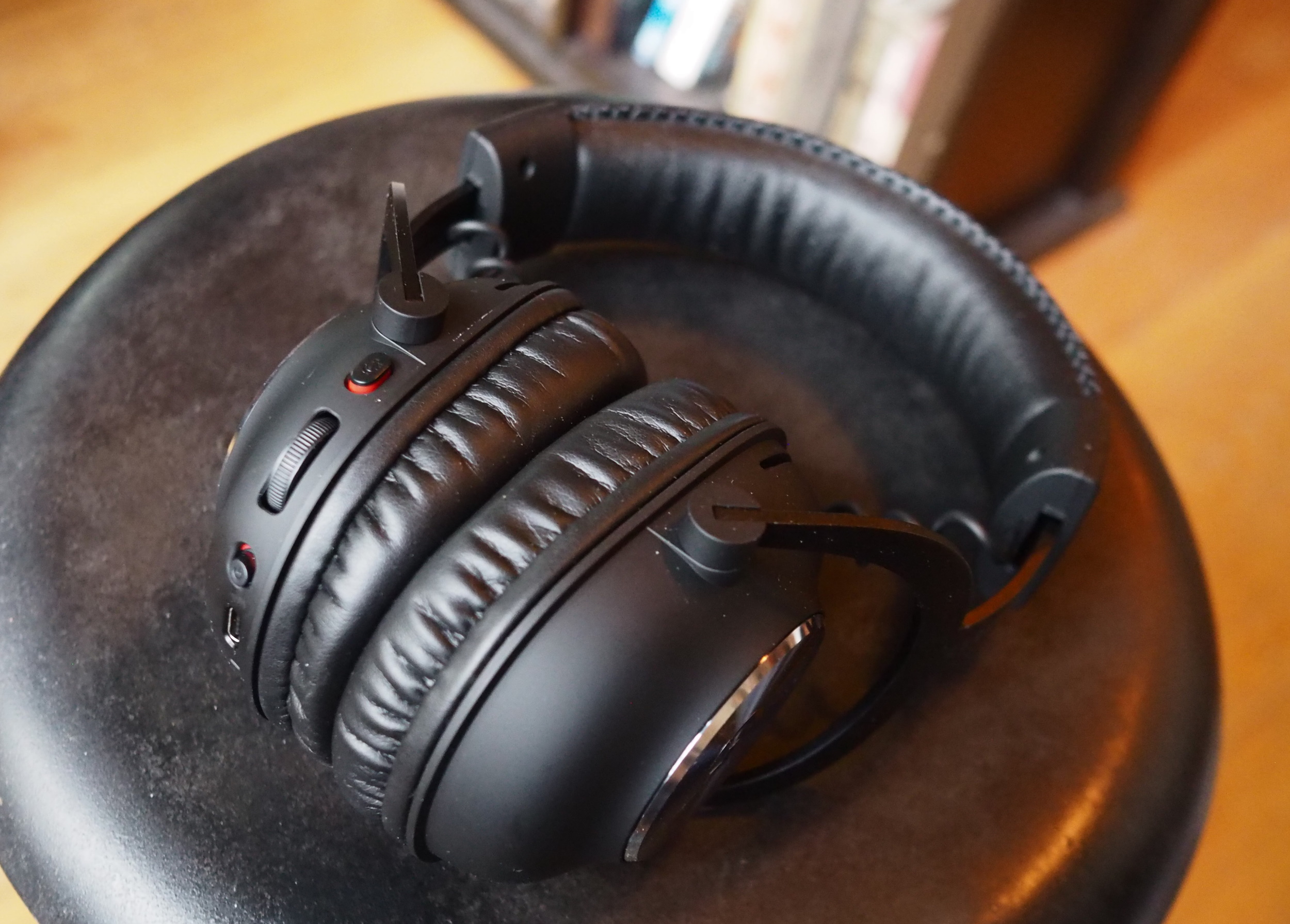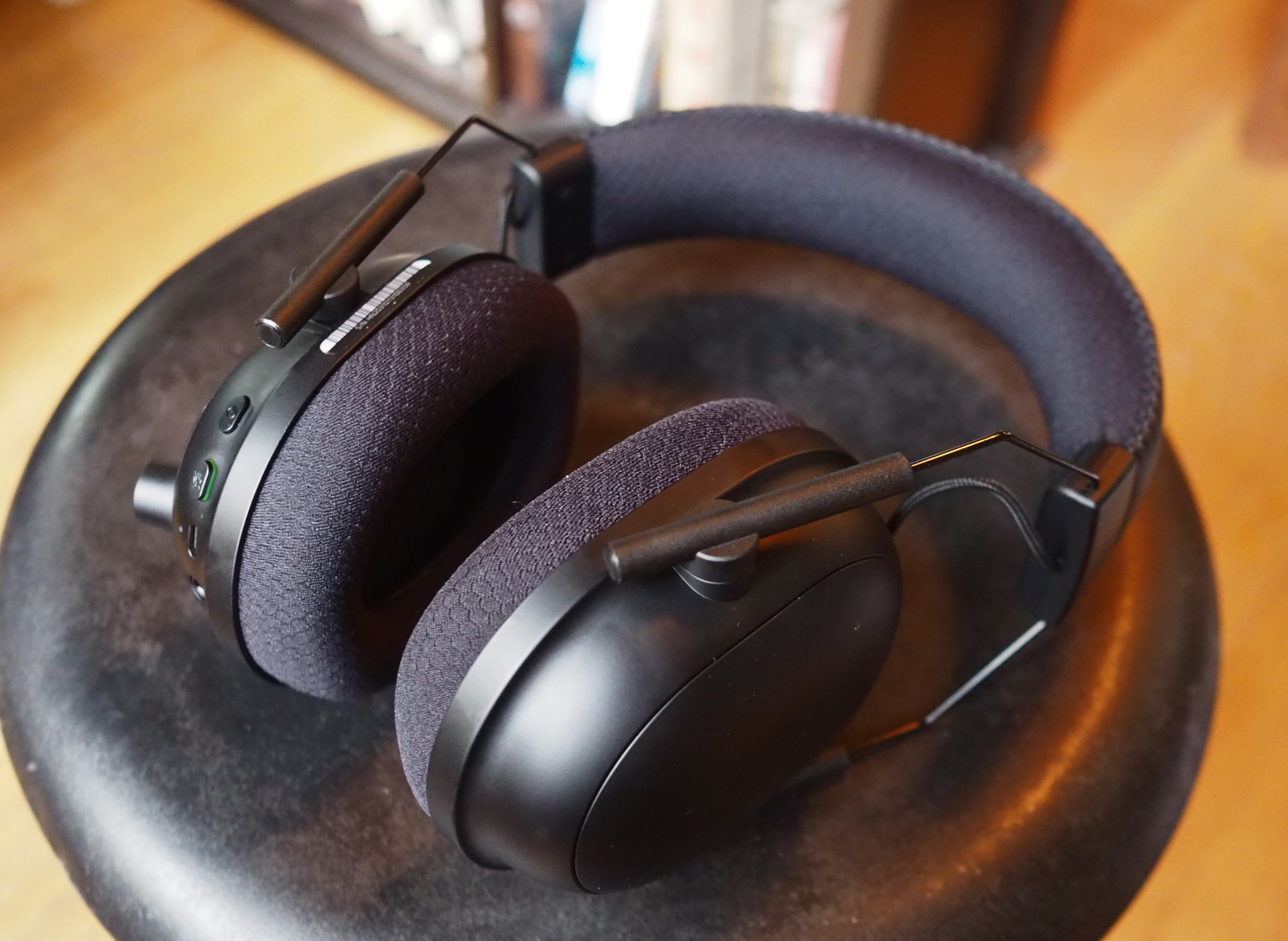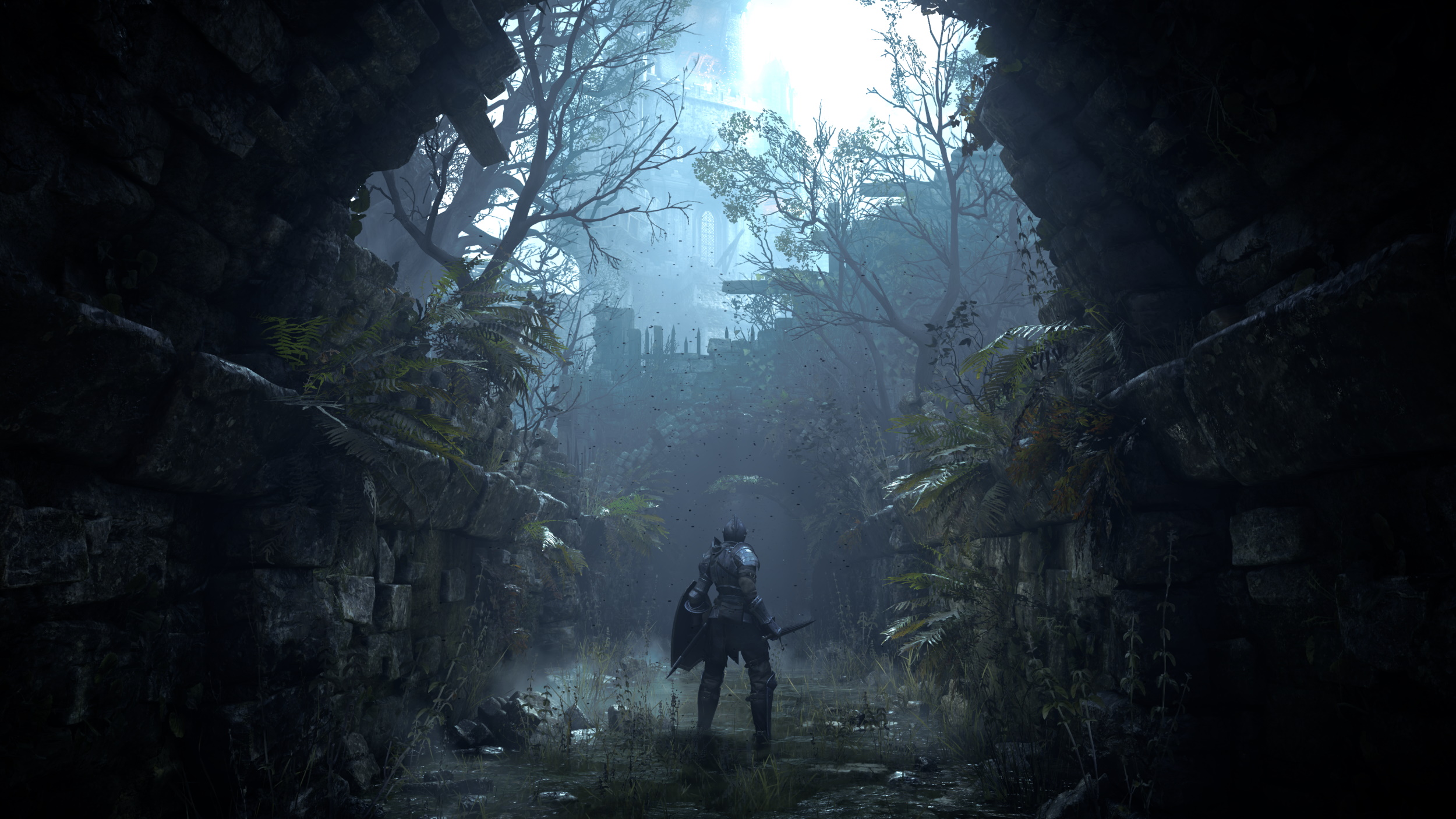TechCrunch
TechCrunch
Wonder, a Berlin startup that has built a platform for people to come together in video-based groups to meet up, network and collaborate, while also having a birds-eye view of a larger space where they can more serendipitously, or more intentionally, interact with others — not unlike in an office or other business venue — is today announcing that it has raised $11 million (€9 million) in a substantial seed round.
The funding was led by European VC EQT Ventures, with BlueYard Capital — which led a pre-seed round in the startup when it was previously called “YoTribe” — also participating.
It comes on the heels of the young startup seeing some impressive traction this year.
Wonder now has 200,000 monthly users from a pretty diverse set of organizations, including NASA, Deloitte, Harvard and SAP, which are using it for a variety of purposes, from team collaboration through to career fairs. The company will use the funding both to add in more features as requested by current users, as well as to hire more people for its team, co-founder Stephane Roux said in an interview. Those features will include sharing files and other technical services, but they will not be piled on quickly or thickly.
“We think of this less in terms of content and more about people,” he said. “The core experience is about live interaction, just just repositories of stuff. We want to build a place for collaboration and communication. Interesting ways to carve up a group virtually.”
Now, you may be thinking: another workplace video app? Hasn’t this $14 billion space race already been “won” by Zoom (which some of us now use as a verb for videoconferencing, regardless of which app we actually use)? Or Microsoft or Google or BlueJeans, or whatever it is that your organization has inevitably already signed up and paid for?
But it turns out that for all the growth and use that these other platforms have had, they are sorely lacking in their overall experience, as it pertains to what it’s like to be in physical spaces with other people. One of the key points, it turns out, is that a lot of solutions are not really built with the user experience of the larger group in mind.
Wonder is built around the idea of a “shared space” that you enter. That space comes not from a VR experience as you might expect, but something much simpler that takes a tip from more rudimentary but very effective older game dynamics. You get single window where you can “see” from an aerial view, as it were, all of the other people who are in the same space, and the areas within that space where they might cluster together.
Those clusters could be designed around a around specific interest (such as marketing or HR or product) or — if the product is being used at a career fair, for example, at a list of different companies taking part; or — at a conference — different conference sessions, plus an exhibition space.
You can move around all of the clusters, or start your own, or sit in the margins with another person, and when you do come together with one or more people, you can join them in a video chat to interact. In the future, the plan is to do more than just join a video chat; you might also be able to access documents related to that cluster, and more.
The clusters can be “public” for anyone to join, or set to private, as you might have in a physical meeting room. The overall effect is that, without actually being in a physical space, you get the sense of a collective group of people in motion.
The startup was originally the brainchild of Leonard Witteler, who built a version of this last year as a coding project at university before showing it to friends and family and getting positive feedback.
As another co-founder, Pascal Steck, describes it, he, Witteler and Roux, who all knew each other, had been looking to build a startup together, but around a completely different idea — a portal for photographers and other creatives in the wedding industry.
Given how drastically curtailed weddings and other group gatherings have been this year, that didn’t really go anywhere at all. But the three could see an opportunity, a very different one, with the software that Witteler had built while still a student. So in the grand tradition of startups, they pivoted.
Wonder had previously been called YoTribe, which sounds a little like YouTube and also plays on the idea of groups of friends who come together around special interests.
And from how Steck and Roux described it to me in an interview (over Wonder of course), it didn’t sound like the initial idea was to target enterprises at all, but people who found themselves a bit at a loss when music festivals and other events like that suddenly died a death because of Covid-19.
Indeed, they themselves were all too aware of the state of the market for videoconferencing apps: it was very, very crowded.
“The space is very busy and some great products are already out there. But as soon as you zoom into this space” — no pun intended, Steck said — “when it’s about large group meetings, these other tools do not allow for serendipitous conversations or bottom-up gatherings, and the list gets very thin very quickly. Our focus is around improving presentations, but in the case of large groups, there is just not a lot out there. Especially something building an association as we know it to how we do things in the offline world. We think we have a unique spot in the market.
“A meeting for three people can use Zoom or Teams perfectly. There is no need for anything else, but for larger groups, that is not the case and it seems like the market is really open for something like Wonder.”
The name “Wonder” is an interesting choice when the startup rebranded from YoTribe. Wonder’s main meaning is surprise and discovery, but it has long been thought and assumed that “wonder” is also connected to the word “wander”. (In fact, the two are not related etymologically, but have often crossed paths and wandered into each other’s territories over the centuries.) Similarly, the idea with Wonder the app is that you can “wander” around a room, and find who and what you are looking for in the process.
Wonder is not the only upstart video app that has picked up some attention in the last several months. In fact, there has been a wave of them launching or announcing funding (or both) in 2020 to try to address the gaps — or opportunities — that exist as a result of the features from the current leaders.
Other launches have included mmhmm (Phil Libin’s latest startup that adds lots of bells and whistles to make the presentations more than just a talking head); Headroom (founded by ex-Google and ex-Magic Leap entrepreneurs, using AI to get more meaningful insights from the video conversations); Vowel (which lets people search across video chats to follow up items and dig into what people said across different calls); Descript, Andrew Mason’s audio effort, now also has video features.
But if anything, a lot of these newer tools fail to address the shortcomings of what it’s like being a part of a big group using a video app. In fact, many of these newer entrants highlight another set of challenges, those of the speaker, who is thus graced with better presentation tools in mmhmm, or given way better insights into the audience with Headroom, etc.
In any case, Wonder has found, serendipitously, a lot of traction from people who have identified and lamented the problems with so much else out there today. The app is still free to use, and the plan will be to keep it that way until sometime in 2021, Roux said. Ironically, he pointed out that many of its current customers are asking to be charged, not least because it lends using it more credibility, which is important with IT departments and so on. All that might mean the charging plan gets pushed up sooner.
In any case, even if companies are also using something else, they are also adopting Wonder, and that has in turn piqued the interest of investors who are interested to see where it might go next.
“Throughout Covid-19, real-time video has become the default for both private and professional interactions, and hybrid working is here to stay,” said Jenny Dreier, investor at EQT Ventures Berlin, in a statement. “No other video tools come anywhere near as close to replicating real-life interactions as Wonder, so the product has explosive potential, already foreshadowed with the platform’s stellar organic growth. It’s incredibly exciting to be working with the team and to be part of the journey; I can’t wait to be a part of their next chapter.”
]]>
TechCrunch
TechCrunch
I asked the leading audio and peripheral companies to send over their flagship wireless headset, with prices ranging from about $100 to $250. Beyond this price range returns diminish swiftly, but right now that’s the sweet spot for comfort, sound and usability.
For years I’ve avoided wireless headsets because there were too many compromises, but I’m pleased to say that the latency has been eliminated and battery life in the ones I reviewed is uniformly excellent. (NB: If the wireless version feels too expensive, you can often get wired ones for $50-100 less.)
To test the headphones, I used them all for a variety of everyday tasks, from video calls to movies and music (with only minimal EQing to get a sense of their natural sound) to AAA games and indies. None require an app to work, though some have companion software for LEDs or game profiles. I have a fairly large head and medium-sized ears, for what it’s worth. All the headphones are rather bulky, though the angle I shot them at individually makes them look huge — you can see in the image up top that they’re all roughly the same size.
None of these headphones have active noise cancelling, but many offer decent physical isolation to the point where they offer a “monitor” feature that pipes in sound from the outside world — useful if you’re playing a game but waiting for the oven to preheat or something. Only the first set has a built-in mic, the rest have detachable ones of generally solid quality, certainly good enough for streaming and chatting, though for broadcast a separate one would be better. All these headphones use a USB-A style dongle, though the 7P/7X also has a USB-C connector.
SteelSeries 7P/7X – $149
The 7P and 7X headsets, designed with the PS5 and Xbox Series X in mind (as well as PC) respectively, are my first and most unreserved recommendation.
The standout feature on these is, to me, a truly surprising sound with an almost disturbingly broad stage and clarity. I almost couldn’t believe what I was hearing when I put on some familiar tracks I use for reference. This isn’t a 7.1 simulation or anything like that — but no doubt the gaming focus led to creating a large soundstage. It worked!
I also found the headphones to be very comfortable, with a “ski goggle” strap instead of a per-band adjustment that lets them sit very lightly as well as “remembering” your setting. The spacious earcups rotate for travel or comfort.
The built-in mic is unobtrusive and stows away nicely, but if you’re picky about placement it was a bit floppy to adjust. Many of the other headsets have nicer mics that completely detach — maybe that’s a plus for you, but I tend to lose them.
My main issues with these are that the controls feel cheap and not particularly well laid out. The bottom of the headset is a jumble of ports and buttons and the volume dials don’t have much travel — it’s 0 to 100 in one full swipe. (Volume control is independent from system volume.)
The dongle is different from the others in that it is itself USB-C, but with a USB-A cable attached. That’s good for compatibility, but the cable is three feet long, making it kind of silly to attach to some laptops and whatnot. You could easily get your own short cord, though.
At $150 I think these are an easy recommendation for just about anyone looking at that price range.
Audio-Technica AT-GWL – $250
The high price on these is partly because they are the wireless version of a headset that also comes wired, so if you want the solid audio performance and comfy fit, you can save some money by going wired.
The sound of the AT-GWLs is rich and naturally has a focus on the upper-mid vocal range, which makes voices in media really pop. I did find the sound a bit confined, which hitting the “surround” setting actually helped with. I know that this sort of virtualization has generally been frowned on, but it’s been a while since these settings have been over the top and distortive. I found surround better for games but not necessarily for music, but it’s very easy to switch on and off.
The headphones are light and adjusted with traditional, no-nonsense metal bands, with a single pad on the top. I would say they are the lightest-feeling pair I tested, with the SteelSeries and Razer coming in just behind owing to some extra weight and bulk. Despite being compact, the AT-GWLs felt airy but not big. The leather-microfiber combo cups are nice, and I think they’ll break in well to provide better isolation over time.
Where they fall short is in the interface. First, a note to Audio-Technica: Turn down the notification noises! Turning the headset on, the mic on or off or hitting the system-independent volume max produces loud, surprising beeps. Too loud!
Second, the buttons and dials are stiff, small and same-feeling. Lifting a hand quickly to turn down the volume (maybe after a huge beep) you may very easily mistake the power switch for the volume dial. The dial also doubles as a button for surround mode, and next to it is a microscopic button to turn on and off the sound of surroundings. It’s a bit of a jumble — nothing you can’t get used to, but considering how nice other headsets on this list made their controls, it has to be said.
HyperX Cloud II wireless – $100
HyperX (owned by Kingston) wasn’t exactly known for audio until fairly recently, but its previous Cloud headset got the crucial Wirecutter endorsement, and it’s easy to see why. For less money than any of the other headsets in this roundup, the follow-up to that headset (which I’m wearing right now) has excellent sound and isolation.
I was surprised to find a soundstage nearly as wide as the 7P/7X, but with more of a focus on the punchy lower register instead of on detail and placement. My music felt big and close, and the atmosphere of games likewise, more immediately present.
The Cloud II’s controls are simple and effective. The volume dial, tied directly to the system volume, is superb: grippy, with smooth motion and just the right amount of friction, and just-barely-there clicks. There are two good-size buttons, the power one concave and the mic mute (which gives different sounds for muted and active) convex.
It’s unfortunate that they’re not as comfortable, for me anyway, as the others on this list. The cups (though a bit on the warm side) and band are perfectly fine. It’s that there’s little rotation to those cups, meaning there’s no play to accommodate the shape of your head. I don’t know, maybe it’s just my big dome, but they were noticeably tighter at the front of my ear than the back, so I was constantly adjusting or trying to twist them.
I’ll say this: If they add a bit more adjustment to the cups, these would be my default recommendation over the 7P/7X. As exciting as the SteelSeries sound is to me, the Cloud IIs seem more like what people expect, and are $50 cheaper.
Logitech G-733 – $130
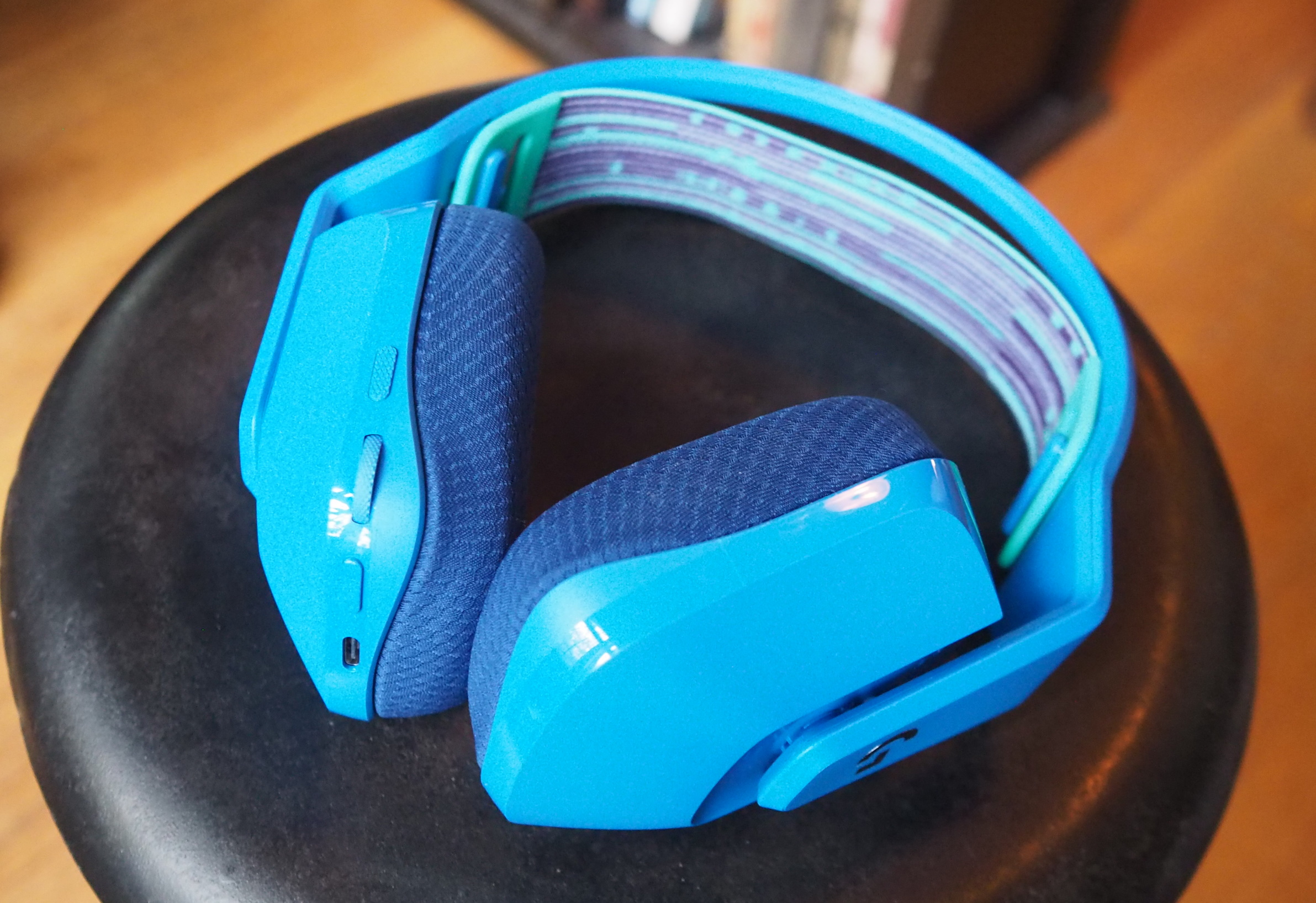


The matte texture of the G733s had a weird interaction with my camera — they don’t look speckly IRL. Image Credits: Devin Coldewey / TechCrunch
These are Logitech’s streamer-friendly, color-coordinated, LED-sporting set, but they’re better than the loud design would suggest.
The sound is definitely gaming-forward, with a definite emphasis on the low end and a very central, present sound that was a lot like the Cloud II.
To be honest, I was not expecting the G733s to be very comfortable — their stiff plastic look suggested they’d creak, weigh down my ears and crush my noggin. But in fact they’re really light and quite comfy! There’s a lot of play in the positions of the earcups. The fit is a little odd in that there’s a plainly inferior version of the 7P/7X’s “ski goggle” strap that really only has four settings, while the cups slide up and down about two thirds of an inch. It was just enough to accommodate my (again, apparently very large) head.
The mic boom is rather short, and sadly there is no indicator for when the mic is on or off, which is sometimes a minor inconvenience and sometimes a major pain. You can tell from the sound the mute button makes, though.
The volume dial is nice and smooth, though the “clicks” are really far apart. I like the texture of it and the mic mute button, the power button not so much. But it works.
The colors may not be to everyone’s liking, but I have to hand it to Logitech for going all the way. The headset, mic and even the USB dongle are all the same shade, making it much easier to keep track of them in my growing pile of headphones and widgets.
Logitech Pro-X – $200
Currently Logitech’s most premium set of gaming headphones, the Pro-X abandon the bright, plasticky look of its other sets and goes for understated and black.
The sound of the Logitech is big and very clear, with almost a reference feel in how balanced the bands are. I felt more presence in the mid-lows of smart bass-playing than the other sets. There is a “surround” feel that makes it feel more like you’re in a room of well-configured speakers than headphones, something that I think emerges from a de-emphasis of the center channel. The media is “out there,” not “in here.” It’s not a bad or a good thing, just distinct from the others.
The controls are about on par with the Cloud II’s: a nice frictiony volume wheel controlling system volume, a nice mic toggle button and a fairly meaty on-off switch you’re unlikely to trip on purpose.
Also like the Cloud IIs, there is no rotation to the earcups, making them less comfortable to me than the ATs and SteelSeries, and Logitech’s cheaper G-733s. A larger head than my own, if that’s possible, would definitely feel clamped. I do think these would wear in well, but all the same a bit of play would help a lot.
The external material, a satinized matte plastic, looks truly lovely but is an absolute fingerprint magnet. Considering you’ll be handling these a lot (and let’s be honest, not necessarily with freshly washed hands), you’re going to need to wipe them down rather more than any of the others I tested.
Razer Blackshark V2 Pro – $180
The understated Razer Blackshark V2 Pro soon became my go-to for PC gaming when the SteelSeries set was attached to the PS5.
Their sound is definitely gaming-focused, with extra oomph in the lows and mid-lows, but music didn’t sound overly shifted in that direction. The soundstage is full but not startlingly so, and everything sounded detailed without being harsh.
The Razers look heavy but aren’t — it varies day to day but I think they’re definitely competing for “most comfortable” with the A-Ts and SteelSeries. The cups feel spacious and have a nice seal, making for a very isolated listening experience. Adjustment is done with the wires attached to the cups, which is nothing special — I kind of wish this setup would let you adjust the cant as well as the height. The material is like the Logitechs — prone to fingerprints, though a little less so, in my experience.
Their controls are very well designed and laid out, all on one side. The protruding (system-independent) volume knob may seem odd at first but you’ll love it soon. The one big notch or click indicates exactly 50%, which is super useful for quick “calibration,” and turning the knob is smooth yet resistant enough that I never once accidentally changed it. Meanwhile there are conveniently placed and distinguishable buttons for mute and power, and ports for the detachable mic, charge cord and 3.5mm input.
I’m hard pressed to think of any downsides to the Blackshark except that it doesn’t work with consoles.
]]>
TechCrunch
TechCrunch
I asked the leading audio and peripheral companies to send over their flagship wireless headset, with prices ranging from about $100 to $250. Beyond this price range returns diminish swiftly, but right now that’s the sweet spot for comfort, sound and usability.
For years I’ve avoided wireless headsets because there were too many compromises, but I’m pleased to say that the latency has been eliminated and battery life in the ones I reviewed is uniformly excellent. (NB: If the wireless version feels too expensive, you can often get wired ones for $50-100 less.)
To test the headphones, I used them all for a variety of everyday tasks, from video calls to movies and music (with only minimal EQing to get a sense of their natural sound) to AAA games and indies. None require an app to work, though some have companion software for LEDs or game profiles. I have a fairly large head and medium-sized ears, for what it’s worth. All the headphones are rather bulky, though the angle I shot them at individually makes them look huge — you can see in the image up top that they’re all roughly the same size.
None of these headphones have active noise cancelling, but many offer decent physical isolation to the point where they offer a “monitor” feature that pipes in sound from the outside world — useful if you’re playing a game but waiting for the oven to preheat or something. Only the first set has a built-in mic, the rest have detachable ones of generally solid quality, certainly good enough for streaming and chatting, though for broadcast a separate one would be better. All these headphones use a USB-A style dongle, though the 7P/7X also has a USB-C connector.
SteelSeries 7P/7X – $149
The 7P and 7X headsets, designed with the PS5 and Xbox Series X in mind (as well as PC) respectively, are my first and most unreserved recommendation.
The standout feature on these is, to me, a truly surprising sound with an almost disturbingly broad stage and clarity. I almost couldn’t believe what I was hearing when I put on some familiar tracks I use for reference. This isn’t a 7.1 simulation or anything like that — but no doubt the gaming focus led to creating a large soundstage. It worked!
I also found the headphones to be very comfortable, with a “ski goggle” strap instead of a per-band adjustment that lets them sit very lightly as well as “remembering” your setting. The spacious earcups rotate for travel or comfort.
The built-in mic is unobtrusive and stows away nicely, but if you’re picky about placement it was a bit floppy to adjust. Many of the other headsets have nicer mics that completely detach — maybe that’s a plus for you, but I tend to lose them.
My main issues with these are that the controls feel cheap and not particularly well laid out. The bottom of the headset is a jumble of ports and buttons and the volume dials don’t have much travel — it’s 0 to 100 in one full swipe. (Volume control is independent from system volume.)
The dongle is different from the others in that it is itself USB-C, but with a USB-A cable attached. That’s good for compatibility, but the cable is three feet long, making it kind of silly to attach to some laptops and whatnot. You could easily get your own short cord, though.
At $150 I think these are an easy recommendation for just about anyone looking at that price range.
Audio-Technica AT-GWL – $250
The high price on these is partly because they are the wireless version of a headset that also comes wired, so if you want the solid audio performance and comfy fit, you can save some money by going wired.
The sound of the AT-GWLs is rich and naturally has a focus on the upper-mid vocal range, which makes voices in media really pop. I did find the sound a bit confined, which hitting the “surround” setting actually helped with. I know that this sort of virtualization has generally been frowned on, but it’s been a while since these settings have been over the top and distortive. I found surround better for games but not necessarily for music, but it’s very easy to switch on and off.
The headphones are light and adjusted with traditional, no-nonsense metal bands, with a single pad on the top. I would say they are the lightest-feeling pair I tested, with the SteelSeries and Razer coming in just behind owing to some extra weight and bulk. Despite being compact, the AT-GWLs felt airy but not big. The leather-microfiber combo cups are nice, and I think they’ll break in well to provide better isolation over time.
Where they fall short is in the interface. First, a note to Audio-Technica: Turn down the notification noises! Turning the headset on, the mic on or off or hitting the system-independent volume max produces loud, surprising beeps. Too loud!
Second, the buttons and dials are stiff, small and same-feeling. Lifting a hand quickly to turn down the volume (maybe after a huge beep) you may very easily mistake the power switch for the volume dial. The dial also doubles as a button for surround mode, and next to it is a microscopic button to turn on and off the sound of surroundings. It’s a bit of a jumble — nothing you can’t get used to, but considering how nice other headsets on this list made their controls, it has to be said.
HyperX Cloud II wireless – $100
HyperX (owned by Kingston) wasn’t exactly known for audio until fairly recently, but its previous Cloud headset got the crucial Wirecutter endorsement, and it’s easy to see why. For less money than any of the other headsets in this roundup, the follow-up to that headset (which I’m wearing right now) has excellent sound and isolation.
I was surprised to find a soundstage nearly as wide as the 7P/7X, but with more of a focus on the punchy lower register instead of on detail and placement. My music felt big and close, and the atmosphere of games likewise, more immediately present.
The Cloud II’s controls are simple and effective. The volume dial, tied directly to the system volume, is superb: grippy, with smooth motion and just the right amount of friction, and just-barely-there clicks. There are two good-size buttons, the power one concave and the mic mute (which gives different sounds for muted and active) convex.
It’s unfortunate that they’re not as comfortable, for me anyway, as the others on this list. The cups (though a bit on the warm side) and band are perfectly fine. It’s that there’s little rotation to those cups, meaning there’s no play to accommodate the shape of your head. I don’t know, maybe it’s just my big dome, but they were noticeably tighter at the front of my ear than the back, so I was constantly adjusting or trying to twist them.
I’ll say this: If they add a bit more adjustment to the cups, these would be my default recommendation over the 7P/7X. As exciting as the SteelSeries sound is to me, the Cloud IIs seem more like what people expect, and are $50 cheaper.
Logitech G-733 – $130



The matte texture of the G733s had a weird interaction with my camera — they don’t look speckly IRL. Image Credits: Devin Coldewey / TechCrunch
These are Logitech’s streamer-friendly, color-coordinated, LED-sporting set, but they’re better than the loud design would suggest.
The sound is definitely gaming-forward, with a definite emphasis on the low end and a very central, present sound that was a lot like the Cloud II.
To be honest, I was not expecting the G733s to be very comfortable — their stiff plastic look suggested they’d creak, weigh down my ears and crush my noggin. But in fact they’re really light and quite comfy! There’s a lot of play in the positions of the earcups. The fit is a little odd in that there’s a plainly inferior version of the 7P/7X’s “ski goggle” strap that really only has four settings, while the cups slide up and down about two thirds of an inch. It was just enough to accommodate my (again, apparently very large) head.
The mic boom is rather short, and sadly there is no indicator for when the mic is on or off, which is sometimes a minor inconvenience and sometimes a major pain. You can tell from the sound the mute button makes, though.
The volume dial is nice and smooth, though the “clicks” are really far apart. I like the texture of it and the mic mute button, the power button not so much. But it works.
The colors may not be to everyone’s liking, but I have to hand it to Logitech for going all the way. The headset, mic and even the USB dongle are all the same shade, making it much easier to keep track of them in my growing pile of headphones and widgets.
Logitech Pro-X – $200
Currently Logitech’s most premium set of gaming headphones, the Pro-X abandon the bright, plasticky look of its other sets and goes for understated and black.
The sound of the Logitech is big and very clear, with almost a reference feel in how balanced the bands are. I felt more presence in the mid-lows of smart bass-playing than the other sets. There is a “surround” feel that makes it feel more like you’re in a room of well-configured speakers than headphones, something that I think emerges from a de-emphasis of the center channel. The media is “out there,” not “in here.” It’s not a bad or a good thing, just distinct from the others.
The controls are about on par with the Cloud II’s: a nice frictiony volume wheel controlling system volume, a nice mic toggle button and a fairly meaty on-off switch you’re unlikely to trip on purpose.
Also like the Cloud IIs, there is no rotation to the earcups, making them less comfortable to me than the ATs and SteelSeries, and Logitech’s cheaper G-733s. A larger head than my own, if that’s possible, would definitely feel clamped. I do think these would wear in well, but all the same a bit of play would help a lot.
The external material, a satinized matte plastic, looks truly lovely but is an absolute fingerprint magnet. Considering you’ll be handling these a lot (and let’s be honest, not necessarily with freshly washed hands), you’re going to need to wipe them down rather more than any of the others I tested.
Razer Blackshark V2 Pro – $180
The understated Razer Blackshark V2 Pro soon became my go-to for PC gaming when the SteelSeries set was attached to the PS5.
Their sound is definitely gaming-focused, with extra oomph in the lows and mid-lows, but music didn’t sound overly shifted in that direction. The soundstage is full but not startlingly so, and everything sounded detailed without being harsh.
The Razers look heavy but aren’t — it varies day to day but I think they’re definitely competing for “most comfortable” with the A-Ts and SteelSeries. The cups feel spacious and have a nice seal, making for a very isolated listening experience. Adjustment is done with the wires attached to the cups, which is nothing special — I kind of wish this setup would let you adjust the cant as well as the height. The material is like the Logitechs — prone to fingerprints, though a little less so, in my experience.
Their controls are very well designed and laid out, all on one side. The protruding (system-independent) volume knob may seem odd at first but you’ll love it soon. The one big notch or click indicates exactly 50%, which is super useful for quick “calibration,” and turning the knob is smooth yet resistant enough that I never once accidentally changed it. Meanwhile there are conveniently placed and distinguishable buttons for mute and power, and ports for the detachable mic, charge cord and 3.5mm input.
I’m hard pressed to think of any downsides to the Blackshark except that it doesn’t work with consoles.
]]>
TechCrunch
TechCrunch
It’s a great time to be a gamer — I mean, what else is there to do? And with the prospect of a long winter and lonely holiday season ahead of us, here’s a list of games on all the major platforms that you can really sink your teeth — and a few dozen hours — into.
Buying for a gamer and have no idea what’s worthwhile? Once you’ve figured out which gaming system is their platform of choice, any of these should be guaranteed wins.
This article contains links to affiliate partners where available. When you buy through these links, TechCrunch may earn an affiliate commission.
Assassin’s Creed: Valhalla
I genuinely enjoyed AC: Odyssey’s gorgeous landscapes and main characters, but the game systems felt disconnected and arbitrary. That’s much less the case with AC: Valhalla, which tells a similarly sprawling tale of Vikings in England but works a little harder to put it together into a cohesive whole. It’s still very much “Ubisoft Game, but with Vikings” but that’s not necessarily a bad thing.
Price: $50 from Amazon
Minecraft Dungeons


Price: $20-30 (depending on platform) from Mojang
Call of Duty: Black Ops Cold War
Reviewers agree: The new CODBLOPS is definitely more CODBLOPS. The latest in the gritty military series is the one everyone will be playing for the next year, so it’s definitely a must-have for quite a few people.
Price: $50-60 (depending on platform) from Amazon
Cyberpunk 2077
Cyberpunk 2077, the futuristic RPG from the creators of the Witcher, isn’t out yet, but it’s one of the most anticipated titles in recent years and your special someone might like the idea that they’re getting it day one. Of course if it’s anything like The Witcher 3, they’re probably going to want to wait a few months for the bugs to get ironed out. But hey, it’s an option.
Price: $50 from Amazon
Spider-Man: Miles Morales
This semi-sequel to the much-lauded 2018 Spider-Man is smaller in scale but plays even better. Plus it has a wonderfully inclusive cast and tone and feels authentic, where the original, for all its strengths, had a pretty flat take on New York. Bonus: If you buy the PS5 version of Miles Morales, you get the remastered 2018 game for free. I’d argue you’re simply not going to find a better bang for your buck right now with any other new game.
Price: $50 on Amazon
Demon’s Souls
The only “true” next-generation game out there right now is a remake of a PlayStation 3 game, and in many ways it feels like it. But in other ways, it’s the most amazing game on the market right now. If your loved one has enjoyed Dark Souls, Bloodborne, Sekiro and other incredibly hard games, this is the one to get.
Price: $70 on Amazon
Ghost of Tsushima


Between Nioh 2, Sekiro and Ghost of Tsushima, there’s a real bumper crop of samurai and ninja action to be had. But Ghost is the broadest and most beautiful of them all — if not necessarily the deepest.
What it lacks in challenge… first of all, is more than made up by the difficulty of those other two games I mentioned, give me a break. But Ghost’s draw is in the unity and beauty of its game world and systems. For example, instead of a quest marker or arrow pointing toward your objective, the wind is just always blowing in that direction. Amazing, right? The single player campaign is remarkably well acted, and a free update has brought a surprisingly extensive multiplayer co-op mode as well. This is truly a game you can lose yourself in. Just don’t start trying to collect everything or you’ll never leave the first area.
Price: $40 on Amazon
13 Sentinels: Aegis Rim
This totally unique game came out of left field and obsessed me for two solid weeks. A combination of adventure game, visual novel and tactical action game, 13 Sentinels puts you in charge of a bunch of high school kids piloting giant robots to save the world from alien invaders. (In case you can’t tell, it’s a Japanese production.)
Sound familiar? That’s the idea — and then it starts pulling rugs out from under you and doesn’t stop until the last few minutes. The labyrinthine story, which progresses simultaneously through 13 interwoven narratives, is the very best kind of sci-fi mind-boggler and a pleasure to unravel from start to finish. The combat is also compelling and satisfying, if not particularly deep or challenging. There’s simply nothing else like this out there.
Price: Currently $30 from GameStop
Halo: The Master Chief Collection
If your loved one is a Halo fan, they’re likely very sad since Halo: Infinite, once a launch title for the new console, won’t be coming out until next year. But it can’t hurt to have the original games all updated and beautified to play through as an appetizer. Plus there’s the famous Halo multiplayer to get everyone through the winter.
Price: $30 from Amazon
Yakuza: Like a Dragon
The latest in the long-running and beloved Yakuza series of character-driven adventures of Japanese gangsters set in a fictional Tokyo neighborhood, this one changes up the style with a turn-based combat system and new protagonist — but some are calling it the best yet.
Price: $35 from Amazon
Gears Tactics
No one really expected that the Gears of War series would lend itself to a tactics game in the style of XCOM — let alone that it would leapfrog others in the genre and become one of the best you can get, period. Naturally it isn’t quite the urgent, visceral experience that Gears normally is, but this is a surprisingly deep and engrossing game.
Price: $38 from Amazon
Ori and the Will of the Wisps
The sequel to the lauded “metroidvania” Ori and the Blind Forest is technically on several platforms, but the Series X seems to be the absolute best one on which to play it. With beautifully updated art and a silky-smooth framerate, this will look better on that new 4K HDR TV than many “real” next-generation games. But don’t let the beautiful yet cute art style make you think this will be a cakewalk. Like the first in the series, you’ll need some serious dexterity to complete this platformer.
Price: $30 from Moon Studios
Risky move: Preorder Halo: Infinite
No one is quite sure whether the first Halo of the next generation is going to be as good as everyone hopes, and a delay to early next year didn’t allay anyone’s fears. That said, many a gamer will cherish the idea of playing the latest in this venerable series day one, so pre-ordering a copy is a possibility if none of the other games really ring their bell.
Price: $60 from Amazon
Mario Kart Live: Home Circuit
Technically this is also a “toy,” because it’s real-life RC carts zooming around your home on an augmented-reality racetrack. We thought it was tons of fun, and it’s a great way to take video games off the TV and into real life… kind of. Just be aware that every player needs their own cart and their own Switch.
Price: $99 from Best Buy
Hyrule Warriors: Age of Calamity
Don’t go into this game expecting a full-on new Zelda title and you’ll do just fine. This is definitely an action game, and a big, rather mindless one at that. But it’s hard to resist the concept of playing as Link, Zelda or any of the champions from Breath of the Wild and dispatching enemies by the hundreds.
Price: $50 on Amazon
Super Mario 3D All-Stars
Okay, I gave Nintendo some guff over the perfunctory nature of this collection of amazing games. I’ve wanted to replay Mario 64 for years and was waiting for Nintendo to touch it up just a bit — but it, and Super Mario Sunshine, and Super Mario Galaxy, are virtually unchanged in this retro package. Really, you couldn’t make it widescreen? But for most, the chance to play these games again (or for the first time) on the Switch is worth the price of admission, period.
Price: $60 from Amazon
Spelunky 2 and/or Hades


Spelunky 2 is the most traditional, in a way. Sequel to one of the best games out there, this one adds more variety, more weirdness and more challenge to the unforgiving platforming of the original. Like before, every death (and there will be a lot) is avoidable and while some runs may last only seconds, it’s hard to be deterred when you know that if you just paid a little more attention, or saved your bombs, or went over that other way… just one more game. (Pro tip: Buy a couple copies for friends and indulge in jolly cooperation.)
Hades combines the procedurally generated levels with an incredibly beautiful art style and an ingenious story and progression system. Escaping from the ever-shifting landscape of Hades, you’re going to die over and over, but as a young god, that’s more inconvenience than obstacle. Meanwhile every death and every inch of progress moves you closer to the mystery of your birth in a clever modern take on Greek mythology. It’s honestly hard to imagine how Hades could be improved in almost any way.
Price: $20 for Spelunky 2 on Steam | $25 for Hades on Steam
Crusader Kings III
This long-awaited strategy title puts you in the throne room of a European medieval dynasty, where you can do… pretty much anything to get ahead. Assassinations, proxy wars, brutal taxes, religious cannibalism, strategic marriages… it’s all on the table. This is a story-telling engine that’s remarkably robust and, once you get past the initial learning curve, very fun. It’s also very, very nerdy, and proud of it.
Price: $50 on Steam
Game & Watch: Super Mario Bros
This little gadget has the original Super Mario Bros., its sequel (not the weird one — what we knew as “The Lost Levels”) and a remade LCD game all built in. It’s a charming device and the games play well, plus you can turn it off and resume progress later, making it that much easier to get through the whole game.
Price: $50 (but finding one in stock can be challenging.)
Backbone One for iPhone
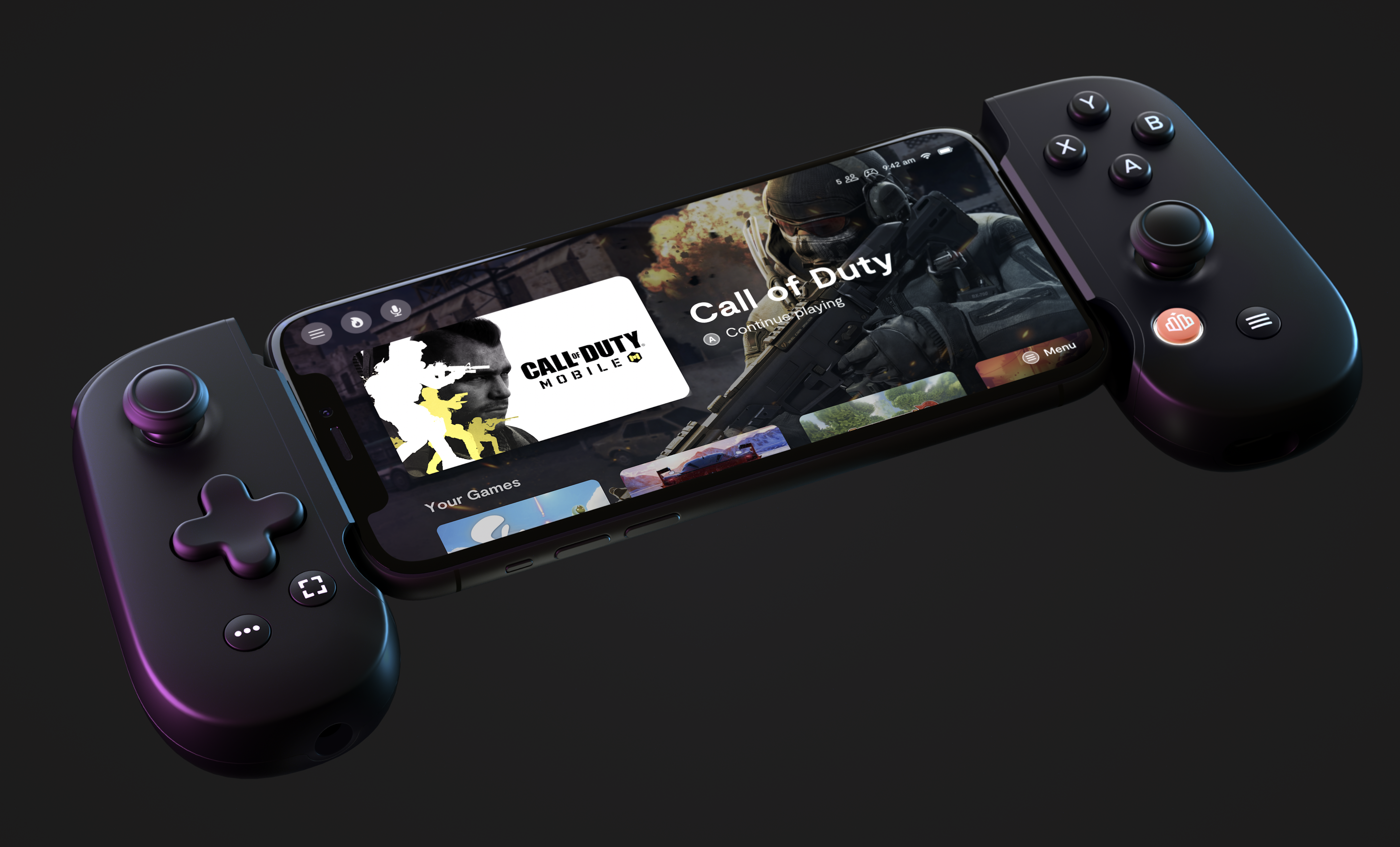

Image Credits: Backbone
Got a friend who prefers to game on their phone? The Backbone is built for them. This snap-on controller brings buttons and analog triggers (and good ones, at that!) into the iOS gaming world, along with a surprisingly solid companion app that can do things like record your gameplay and help you edit and post your highlight reels. It only works with select iOS titles, but the library is growing. TechCrunch Editor-In-Chief Matthew Panzarino reviewed it in October and gave it his stamp of approval with very little reservation.
Price: $99 from Backbone
]]>


